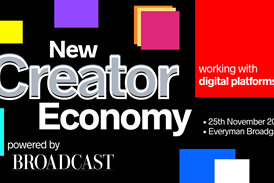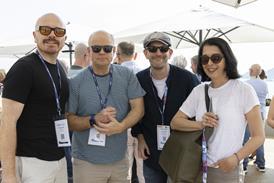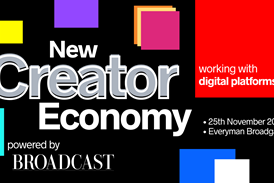Let's get straight to the point. The process of selling a piece of kit to the broadcast and post-production market is now more complicated than it's ever been.
Equipment no longer stands alone. It must be able to talk to other parts of a workflow chain made up of multiple manufacturers' equipment.
And it must be able to perform in an environment where content is repurposed for lots of different platforms.
Then, to cap it all, both of these requirements are intertwined with IT, a world that is new to some parts of television.
“There is a much higher level of risk with these next-generation broadcast requirements than there was with a traditional upgrade,” says Roger Crumpton, director of the International Association of Broadcast Manufacturing. “They require new architectures and new approaches that people are still exploring at the moment. And they are enterprise IT projects and that demands a different style of project management.”
To a certain extent, of all the markets that are served by the IT industry, broadcast is the last one to undergo an IT-type business transformation. “This is because of how obscure and difficult the technological issues were to address,” says Paul Glasgow, general manager of Avid Technology in the UK. “What we need are people who understand both sides of the coin: the broadcast workflows and the IT integration. There are not many companies which do that.”
For the manufacturers the shift to an end-to-end, non-proprietary workflow environment points to three route-to-market priorities: product support, interoperability and systems integration.
Finding the right route
In the UK the routes to market taken by the companies that develop post-production applications vary wildly.
Apple has an impressive online operation and countless resellers while Quantel, Cintel and Digital Vision sell direct. Avid spreads its net far and wide - going direct, via resellers and selling online - while Autodesk has a very strict two-stream structure to its reseller sales channel.
For Apple the route to market is almost irrelevant as customers are able to do a myriad of things with its commodity software and hardware. “The move to commodity IT breaks the stranglehold that the manufacturers have over the customer,” explains an Apple spokesperson. “Apple just makes a box. You can do what you want with that box.”
Autodesk's media and entertainment reseller channel is divided into two business units, software and systems, both overseen by channel managers. This is done to provide dedicated and specialist focus on product lines. The systems resellers provide Autodesk customers with local knowledge and have the added advantage of being able to demonstrate the interoperability of products.
“We've got key resellers who focus on their own market who have found their own niche,” explains Robin Adams, EMEA systems manager at Autodesk. “But the benefit of the reseller is not just that it will represent other manufacturers but it'll also have a demo site so users can evaluate a whole system and see it working.”
Quantel, on the other hand, only sells direct. Its market is high-end post-production and broadcast. Director of marketing Steve Owen believes a direct sale is the best way for the company to truly understand the client's ever-changing challenges. “We get information straight from the customer into the business,” he says. “We're not selling simple little products.”
However, Quantel does not operate as a closed shop and it will partner with other manufacturers, systems integrators and resellers on projects. “No one company can do it all today,” says Owen.
Avid Technology, as Glasgow puts it, has a “broad spectrum of mechanisms to engage.” Which means the company sells directly and indirectly depending on the product. At one end of the scale, “shrink wrapped” Media Composer software can be bought online. At the other, each of the major broadcasters is assigned a dedicated account manager.
In between are the companies that are regarded by Avid as gold tier, resellers such as Root6 and Altered Images. “They add a lot of value by integrating with other products and understanding workflows,” says Glasgow.
Resellers also bring new ideas and products to the table. Root6 deals in hardware and software - including product from both Apple and Avid. Director John Harris says his company has two roles to play in the new order of things. “We take the technology to market and we also explain how the market works to the manufacturer,” he says.
He cites the example of Isilon, a storage supplier from the IT industry, that has perfect products for these changing times but little expertise in the video market. “We've been asked to qualify their product for them,” says Harris. “We will be coming up with a statement saying ‘this is what it can achieve.'”
Integrating systems
With the robustness of the whole system now more important than the individual product, intermediaries such as systems integrators (SIs) have a crucial role to play.
An SI is an individual or company that combines various components and programs into a functioning system, customised for a particular customer's needs. But there is now much more to it than that. It's not just plugging stuff together. The SI is now an IT specialist, a solutions provider and an independent source of advice. And they can provide benefits for both customers and manufacturers.
Some broadcasters, because they now have fewer engineering and technical staff, rely heavily on the SI market and outsource their technology expertise and requirements to them.
This approach has many advantages, according to David Phillips, chief executive of TSL, an independent integrator that works with many of the major broadcasters. “Not least they [broadcasters] get a guaranteed level of service on tap without having the cost of overhead on the organisation.”
Harris at Root6, which is both a reseller and an integrator, sums up the shift in technical expertise. “The broadcaster's knowledge is on the production process side,” he says. “Our's is applying new technology to it.”
But using an SI is certainly not about papering over the gaps in the engineering department. It provides broadcasters with an objective middle man, as Graham Buchanan, managing director of integrator ATG Broadcast, explains. “Significant complications rarely arise,” he says. “But when they do it is our responsibility to identify which combination of equipment or interface protocols is creating the challenge and then to overcome it. The last thing a broadcaster needs is to be pressured between suppliers trying to blame each other.”
Some integrators, such as TSL, like to pre-build a system before it is installed in order to avoid problems further down the line. “While that wasn't essential a few years ago we now deem it as crucial because you can bring the suppliers together in advance in order to iron out the issues,” says Phillips. “The value is in ensuring that the total system works as the customer wants. If you haven't done the testing thoroughly then the fingerpointing can start.”
Manufacturers also benefit from the SIs' ability to widen the marketing net. “Our route to market is not entirely driven by what the EMEA video industry wants,” says Winfried Schultz, marketing manager at test and measurement product maker Tektronix. “A lot of our stuff goes into systems so we're using a lot of systems integrators. They sell our products because many people want turnkey solutions.”
Digital Vision is also seeing more involvement from SIs as the company has started to introduce non-linear grading products to the broadcast market. “Quite often a broadcaster, having negotiated with us directly, will point to its preferred integrator to buy the product,” says chief operating officer Simon Cuff, who also notes that products can be bought direct but still installed by integrators. “Post house Pepper bought four of our systems and a DVS SAN. But they got Boxer Systems in to do the routing, cabling, integration and configuration.”
Providing support
Professional equipment used to mean three things: it was proprietary, it was expensive and you needed help in order to use it. With the influx of commodity technology, you can buy online and install new toys yourself. But that doesn't mean product support has become less important.
Autodesk has invested in a worldwide support infrastructure that provides 24-hour help. If an end-user buys a support contract from a reseller it is ultimately fulfilled by Autodesk. “We see it as investing in channels so that they are able to provide the frontline support,” says Adams. “With support infrastructure resources in London, Montreal, Australia and in LA if you have a problem at 3am you will still be able to get some help from somewhere in the world.”
Support can also be an extra revenue source. Steve Angel, sales director of audio reseller HHB, dedicates 20% of the company's head count to technology support. “There is not a lot of margin in software,” he says. “So support is a big thing for us. A lot of those guys are generating non-product-related income by doing training, installation and set-up.”
Digital Vision, which offers a premium support package that includes software upgrades as well as web and telephone assistance, has initiated other methods of problem solving. “We've put a few indicator lights on our graphical user interface that tell users what is going on,” explains Cuff. “The most common thing that happens is that [our equipment is] not playing real-time and that could be caused by a virus or an operational error. The lights will tell users that there is something wrong with the disk drive for example.”
Eamonn Dowdall, managing director of Gearhouse Broadcast - both a reseller and a systems integrator - thinks the move to new technology standards has pushed some customers out of their comfort zones. “In SD people felt that technically they could get by,” he says. “In a lot of cases when people are building HD systems, such as studios, they are looking for a bit more support whether they're paying for it upfront or it's part of the deal. We play on that.”
Online forums and user groups are now also a big part of many support networks. Apple product managers regularly watch online forums, get involved in user groups and have access to information provided in the product feedback forms that are supplied with products. That way, according to Apple, “the information ends up directly in the product managers' hands”.
Cintel, maker of scanning products that sit at the very beginning of the post-production workflow, is proud of its support but also acknowledges that it doesn't end once the content passes through to the next stage. “It's become an education for us and our support team to understand more of the other products and the infrastructure around our own products,” says business development manager Simon Clark.
Which brings us neatly back to the point: selling equipment is more complicated today. But because manufacturers are reinventing their business models and acting as educators as well as partners, they are dealing with it and finding new ways to bring their products to market.


























No comments yet